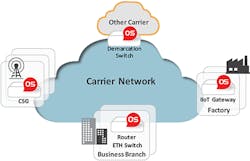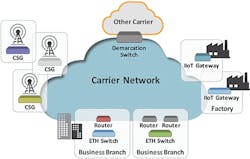Latest from 5G/6G & Fixed Wireless Access/Mobile Evolution
It’s Time to Reinvent Your Business Case
It’s Now or Never in the Era of Transformation —
Lucrative business offerings, from SD-WAN vendors, cloud-based enterprise application providers, and cloud providers, are cannibalizing traditional telcos’ market share, and putting their growth at risk. But rather than presenting simple alternatives to such disparate, low-cost services, telcos must employ forward thinking and become indispensable to their customers.
To do so, they need a new service mix that allows enterprises an option to access new offerings yet provides a more holistic approach addressing critical gaps, such as:
• End-to-end performance visibility and quality of experience (QoE)
• Security
• Always-on operations and business continuity
Luckily for telcos, the competing providers don’t adequately address these gaps. This presents a unique opportunity for telcos, whose close familiarity with their business customers’ needs can be harnessed to build a new path for growth.
InvisiLight® Solution for Deploying Fiber
April 2, 2022Go to Market Faster. Speed up Network Deployment
April 2, 2022Episode 10: Fiber Optic Closure Specs Explained…
April 1, 2022Food for Thought from Our 2022 ICT Visionaries
April 1, 2022Trends in Enterprise Business Services and the OTT Threat
Today’s enterprises expect their network business services to better fit their needs, in terms of customized offerings and fast introduction of new services and upgrades. In general, they want to receive higher value at a lower cost.
SD-WAN vendors, for example, present a business case that’s hard to ignore: a cut-rate over-the-top (OTT) alternative to IP/MPLS VPNs that helps reduce enterprises’ expensive transport costs. To address potential performance issues, they propose to use multiple links for backup/load balancing and application-based steering to improve user experience. Security is offered via traffic encryption over the public Internet.
The trend towards SD-WAN is inevitable; however, these measures are insufficient to back up hard SLAs, which happen to be another key enterprise requirement.
Beyond SD-WAN, there are other services that can be viewed as OTT in the sense that they are agnostic to the transport network over which they are run. Public cloud services are no longer reserved to tech-savvy individuals or to short-term non-production tasks; both SaaS and IaaS services are becoming real substitutes to IT services and to entire data centers. Some predict that within a few years’ time, enterprises will become data center-less, where their entire IT operation is set off the public cloud, or, more precisely, off multiple clouds.
This ongoing transformation means that branch site traffic doesn’t need to traverse the enterprise headquarters as before. It could be backhauled directly to public clouds, where IaaS and applications such as Salesforce, Office365, and others, reside.
The playing ground has therefore grown crowded as telcos are forced to share their market with cloud providers, SD-WAN vendors and other OTT players. They need to find ways to avoid sliding down the value chain to become providers of access network "plumbing". (See Figure 1.)
Figure 1. Network transformation and the OTT threat.
Many service providers are opting for reselling of OTT SD-WAN. Instead, they can adopt an SD-WAN service model that allows them to reinvent their business case by leveraging their assets and enhancing their services offering. They need to become relevant again to their business customers, and even expand their target customer base.
Enter Network Disaggregation
Disaggregating software from the hardware appliance on which it runs represents a dramatic market inflection point. It allows telcos to expedite the process of certifying, onboarding, and productizing, new services.
Virtualized customer premises equipment, or vCPE, has been the most popular use case for network disaggregation, and is likely to remain so in the near future. vCPE’s allure lies in its ability to allow providers to launch new services, such as a combination of networking, security, and IT services, which they haven’t typically offered before.
These can be specifically tailored for various market segments such as hospitality, retail, and supply chain management. Retail businesses, for example, can be offered point-of-sale applications, digital video recording, managed RFID tags, etc., all bundled on a single platform, added or removed to meet specific needs.
With SDN control and automation tools, such as zero-touch provisioning (ZTP), launching, and delivering, new value-added services — either from the provider’s own data center or from the customer premises — can be streamlined. Such agility and flexibility result not only in better time-to-market but also in improved customer experience. Happy customers are less likely to migrate to the competition.
With disaggregation, value-added services can be deployed either on premises, hosted in the vCPE, or of the service provider’s data center.
Consumers of cloud services are often nomad employees, away from their offices or IoT devices that are located outside the business premises. It is desired to create a business perimeter that serves all end-points consuming cloud services. By applying vCPE disaggregation, business perimeter functionality can be hosted in the service providers’ data center, serving end-points accessing the cloud, regardless of their location.
Telco-Hosted Cloud On-Ramps
Service providers can leverage their network assets and offer cloud-bound services with guaranteed end-to-end SLA. In this manner, cloud-bound traffic will be anchored in the service provider’s data center, giving it better control over business services, and giving the opportunity to enrich its offering with value-added services, and, more specifically, with cloud on-ramp services.
Cloud on-ramp services are designed to address CIO/CISO concerns in a changing environment created by the transformation to the cloud and the move of the business perimeter away from customer sites. These services address IT administrators’ desire to gain visibility into their cloud environments, applications usage and user behavior, and, most importantly, to enforce security onto their cloud-hosted workload. Cloud on-ramps can also glue together multi-cloud environments to allow chaining of dispersed applications and resources.
Instead of using individual, best-effort interconnections to multiple cloud providers, a business site could connect to the service provider’s data center and reach multiple destination clouds from that point, with hard end-to-end SLA.
As cloud on-ramps are becoming increasingly popular, there is no reason why telcos shouldn’t offer their own alternative to private cloud access and colocation providers, thereby participating in the cloud business value chain. (See Figure 2.)
Figure 2. How static networks look today.
The Network Edge Vision
Today’s networks are static and are characterized by multiple edge devices from various vendors, each with proprietary hardware. This translates to many discrete IT integration processes, extensive technician trainings, inflated inventories, the need for configuration management, and more.
With the advent of vCPE, we’re likely to witness a new vision emerging for the edge, in which a single OS can be used for branch Ethernet switches, routers, cell site gateways, Industrial IoT gateways, and wholesale demarcation. (See Figure 3.)
Figure 3. How disaggregation will look in tomorrow’s telco network.
This vision utilizes true disaggregation of software and hardware. With shared characteristics across multiple applications, telcos can reduce inventories and minimize their management integration effort while maximizing efficiency.
In addition, tomorrow’s telco network is bound to be cloud-native.
Like this Article?
Subscribe to ISE magazine and start receiving your FREE monthly copy today!
Service providers will be growing their data centers in the upcoming years to run their virtual network edge, especially around 5G networks. Why not use these same data centers as cloud on-ramps and disaggregated business perimeters to reclaim telco market value?

Ilan Tevet
Ilan Tevet, VP of Marketing and Business Development, RAD, has 20 years of experience managing the life cycle of networking, SDN/NFV, vCPE, industrial IoT, and cybersecurity solutions. For more information, email [email protected] or visit: https://www.rad.com/products/radinsight-pm?utm_source=ISE&utm_medium=article&utm_campaign=DK_2022_TheFullView
Follow Ilan on Twitter @Ilan_T. Follow RAD on Twitter @RADdatacomms, LinkedIn: rad-data-communications and Facebook: RAD.Data.Communications.











